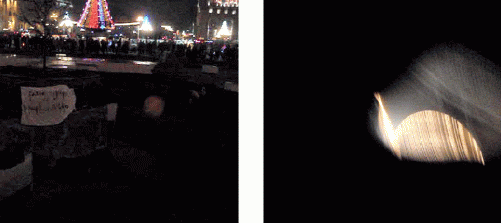I am partially in drag with painted-on moustache, brandishing a blue dildo in my right hand and “shooting” passers-by. I am also reading out loud an excerpt from my unfinished novel Zarubyan’s Women in Armenian. The sounds of music and firecrackers mute my voice. The selected passage is a contemplation of the mechanisms that automatize and deindividualize power that resides in a complex distribution of bodies, lights, sounds, and gazes in which the unhistoried characters are caught up.
Lying prostrate on the ground, lusine talalyan’s gaze is interrupted by transitory death, boredom, desertion, an erotic dream—if the image is an image of war and if the image is at war with itself, then talalyan participates only through an absented presence, a presence that flickers like the Derridian cinder: “By its retreat it still feigns having abandoned the terrain. It still camouflages, it disguises itself, beneath the multiplicity, the dust, the makeup powder, the insistent pharmakon of a plural body that no longer belongs to itself—not to remain nearby itself, not to belong to itself.” (* 1 ) Her gender is indiscernible, like the cinders, she changes sex, she re-cinders and “androgynocides” herself. Lying on a headscarf that is nearly identical with the keffiyeh famously worn by Yasser Arafat, talalyan frames war and its dehumanizing rhetoric that untraces the lives of Palestinian wo/men. This is the iconic image of war that both contaminates and numbs the viewer—it contaminates with a desire to participate, and it numbs through its proliferation in various forms of mass media—one becomes accustomed to life in war.
(* 1 ) Her gender is indiscernible, like the cinders, she changes sex, she re-cinders and “androgynocides” herself. Lying on a headscarf that is nearly identical with the keffiyeh famously worn by Yasser Arafat, talalyan frames war and its dehumanizing rhetoric that untraces the lives of Palestinian wo/men. This is the iconic image of war that both contaminates and numbs the viewer—it contaminates with a desire to participate, and it numbs through its proliferation in various forms of mass media—one becomes accustomed to life in war.
So when a group of young men notice and approach us at the end of our seventeen minute act, they immediately identify and isolate the familiar visual codes of militarism and war, including the poster with the title “Let there be im(war)ge,” choosing to read it—“Let there be war.” The performance is perceived as an act of treason, and the artists as polluters of high cultural values such as masculinity, republicanism, national and military pride. And yet there is a lingering sensation of surprise among the viewers, as the familiar representation of war, naturalized by those very cultural values that they dogmatically uphold, is re-experienced in a new heterodox translation.
Shushan Avagyan ( 2013): IN AND BETWEEN THE (RE)PUBLIC. In: p/art/icipate – Kultur aktiv gestalten # 02 , https://www.p-art-icipate.net/in-and-between-the-republic/




 Artikel drucken
Artikel drucken